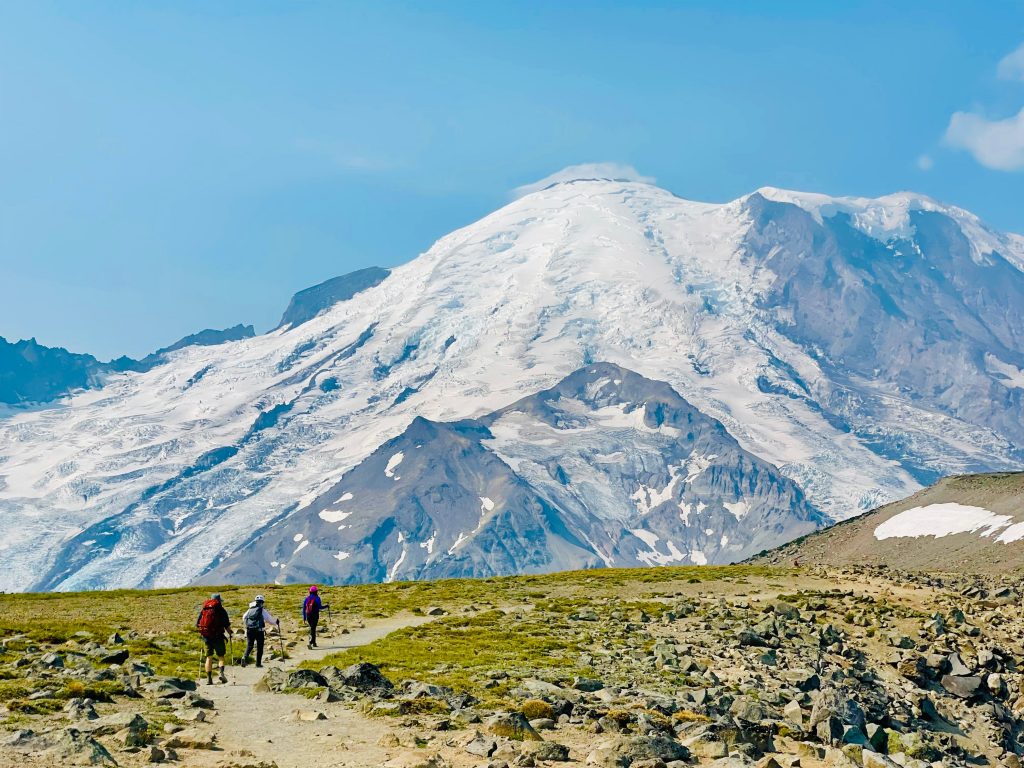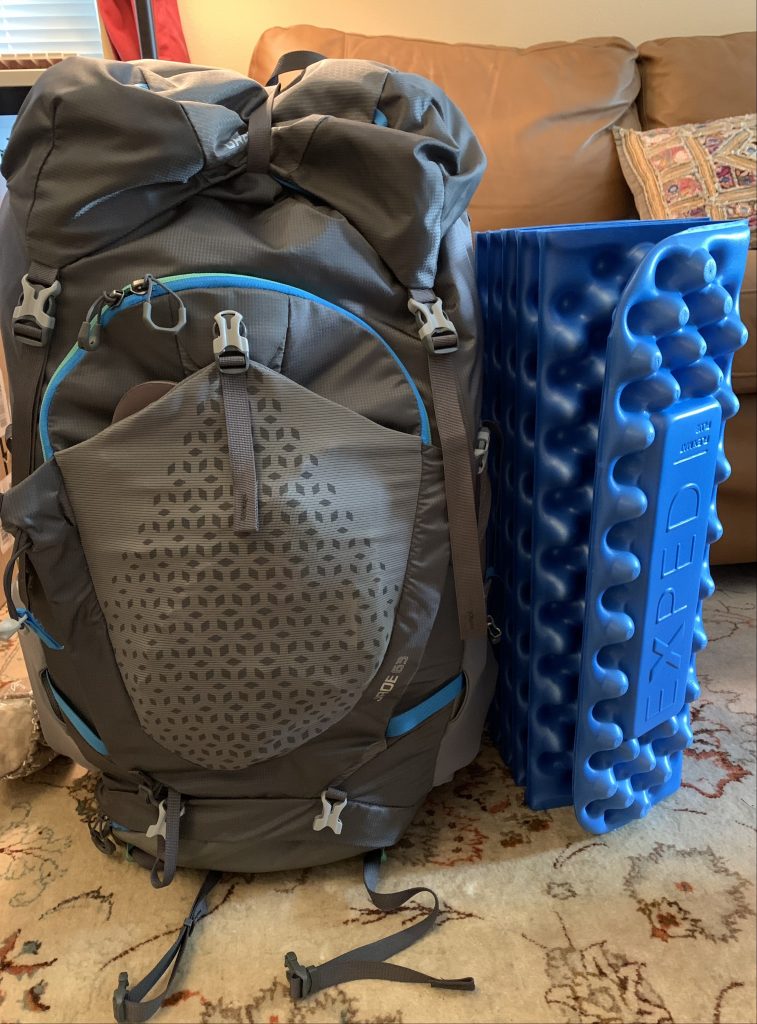
When I first found out I won an early registration lottery to hike the Wonderland Trail in Mt. Rainier National Park this summer, I jumped on the opportunity. The moment the website for claiming group camping registrations opened, it was a quick grab fest, and without much time to hesitate, I clicked and grabbed and clicked and grabbed some more.
Twenty minutes later, I had an itinerary. “I am Wonderland Trail bound!” I thought to myself.
And then, the usual, “Oh, Sh!t! How am I going to pull this off?” questions came flooding in. What gear am I missing? Will I be able to carry everything I need on my back? And of course, the inevitable question came up:
WHAT AM I GOING TO EAT WHILE I AM IN THE WILD?

Photo credit: Imei Hsu August 2021
When I ask people what they eat when they go on multi-day camping trips, the most common answers are:
-trail mix (nuts, seed, raisins, carob or chocolate chunks, coconut flakes
-commercially-made beef jerky and pepperoni sticks
-candy… lots of sugar primarily from corn, such as High Fructose Corn Syrup
-commercially-made freeze dried or dehydrated camping foot, such as Mountain House, Backpacker’s Pantry, and Good to Go
-dried legumes, such as peas, instant oatmeal packets, canned beans, and canned fish
Many of the above choices are nutrient-dense options that help fuel backpackers who may be burning an excess of 3000 calories a day. Yet when I began asking retailers such as REI what they had available for those of us who need Top 8 allergen free as well as allium and nightshade free, most of the commercially available foods completely dropped out from any serious consideration. After perusing over 30 different foods in a dazzling display, a very helpful REI worker and I did not find an option that was Celiac safe, dairy free, soy free, nut free, allium free, and corn free.
“What am I going to eat?” I whispered to myself.
I knew that if I wanted to have food that would keep my guts quiet as a church mouse while delivering the kind of calories I needed for my backpacking experience, I would have to make it myself. Making food myself — and making food fun again! — has always been one of the keys to living well with allergies and autoimmune disease, so I can’t say that I was surprised or disappointed.

If you’re going to carry
it, it had better be
worth it.
The REI salesperson also said that my need for further specialization in the backpacking food world represents a niche market that is unfilled.
Yet I believe it will not likely be filled. Ever. When you take away the garlic, onions, nuts, dairy, sugars, and soy, what remains is something that takes time for the palate to make an adjustment. There just isn’t a significant market to create high-end food with this kind of customization and put it into a format that is freeze-dried, dehydrated, canned, or pressed into a bar. Not enough people would buy it.
So, what is a hungry, adventurous person to do?
ROLL UP MY SLEEVES AND GET COOKING
What does it look like to roll up your sleeves and get cooking for a multi-day backpacking event?
With my Harvest Right three-tray small freeze dryer, each freeze drying session averaged out to be about 30 hours from pre-freeze prep to removing from the trays as a finished food. Add on top of that assembly of the foods into mylar bags, sealing them, and applying labels to each bag to indicate the contents, and we’ll just round that up to 31 hours.
If one session of 31 hours yielded five breakfasts, and another session of 31 hours yield five dinners without a starch, add another session of 31 hours (potatoes, rice, or cooked noodles), 31 more hours for snacks such as cut strawberries, sliced apples, or other fruit, and 31 more hours for a variety of vegetables such as kale, chard, broccoli, and carrots.
Some of the foods had to be cooked and chopped before freezing, such as meat, rice, potatoes, and noodles, cooled, and then frozen on the trays before being inserted into the freeze dryer. So let’s add another five hours to that total.
Total minimum hours = 160 hours
Divide by 8 weekends of monitoring the machine or just being somewhere nearby when the machine beeps at you, and you have estimate across eight weeks of twenty hours devoted to making food to be consumed in six days! Well, now you know why most people buy all the convenience foods they can, and supplement with a few indulgent splurges. This is work, yet don’t be discouraged! For six days on the trail, I was healthy, happy, well-fueled, and had no gut issues whatsoever. Time isn’t the only thing of value. Health is also wealth, and preventative health measures are worth their weight in gold.
My indulgent splurges included:
- Julie’s Real cashew nut butter packets (with cinnamon and vanilla bean)
- Two packages of Sesmark brown rice crackers, gluten free, dairy free, and corn free
- Mung bean thread noodles (one of the few beans I can have)
- 10 EPIC bars (to supplement a lunch on the move)
- Gin Gin chews (a candy I know I can have without reactions and has no corn)
- Dark Cacao powder for a hot drink mornings and evenings
- Wakame sprinkled into morning and evening meals
- Alpine instant coffee
The Freeze Dryer Saves the Day

I’ve already sang the praises of Harvest Right’s freeze dryers for home use. I used it to help prepare food for my trip to New Zealand at the end of December 2019. It came in handy for preparing and storing food during pandemic lockdown in my artloft when I spent a time separated from M while I worked with Public Health among COVID-19 positive patients or suspected COVID-19 patients coming for rapid testing in King and Snohomish Counties. Having food that was easy to prepare — just add hot water! — at the end of a long, tiring shift as a Registered Nurse was really helpful to keep me fed, and it also stretched the food budget. When certain gluten-free certified foods were hard to find on store shelves, my supply of pre-prepared foods were ready for me.
The challenge with freeze drying food are primarily three factors:
- Organizing time — you need to be the operator who starts the machine, loads the food, presses a few buttons at designated times, cleans the machine, and stores the food properly
- Budgeting for bulk food purchases — finding meats, vegetables, or seasonal fruits on sale
- Creating and cooking the foods you think you might want, so you deliver nutrition, flavour, and food interest. If you are not interested in the food when it comes time to eat, you will defeat the purpose of freeze drying, canning, or dehydrating food (the three primary ways most people create foods for storing). This is a known issue among multi-day thru hikers. If they aren’t interested in the food, they keep hiking, lose weight, and then begin to cannibalize their own muscle.
For my trip on the Wonderland Trail and Northern Loop, I treated #3 as a simple project. I made the same breakfasts and same dinners, and used all the other non-freeze dried foods to break up the monotony. For the brevity of my trip, inspiring food interest isn’t much of an issue. For trips that will take longer than seven days, I recommend Batch Cooking while allowing for three or more dinners and three or more breakfast options to break up the monotony and inspire food interest.
Beyond Freeze Drying
Inspiring food interest on travels that don’t involve carrying all your own food can be enhanced by providing fresh food, such as fruits and vegetables in the form of apples, berries, stone fruits if these are tolerated, and salads, greens, and cruciferous vegetables that require light steaming or blanching. We often desire a change in texture, and freeze dried food that is rehydrated tends to have the same texture. On long road trips, we’ve used a Yeti cooler to keep foods cold.
On long road trips into rural areas, it might be easier to find outdoor markets and road-side stands selling seasonal food. If you have a particularly sensitive gut, try cooking your fruits and vegetables, such as softening carrots by blanching in hot water, and parr boiling sliced fruit as a desert or with breakfast. Try to keep your fiber levels from natural, whole foods as close to what they are at home in order to minimize any surprises.
If you can tolerate it, fermented foods in the form of sauerkraut, pickled beets, pickled daikon, and beverages like kombucha or water kefir can help to keep the gut humming at its regular pace. A small bag or container with spices such as dried sage, basil, thyme, salt, pepper, and any other spices you enjoy and can tolerate on your special dietary plan will help add that extra home-cooked touch.
Finally, to hydrate the food with hot water, I packed my own collapsible bowl and collapsible cup, as well as a spoon and fork combo that has a small serrated edge for cutting. Use a disposable wipe or a little water and a reusable cloth to wipe it out after use. There are many brands, so I don’t have a review or recommendation yet. The one I used for my Wonderland trip was from UCO Switch Spork.

You have probably noticed that a lot of the things I did to prepare for a multi-day camping trip can be adapted for long-distance travel that doesn’t involve camping. Having freeze-dried food available buffers in some extra time and energy before you find a safe place to eat when you have food allergies and medically-necessary diet. I’m finding that the investment in a freeze-dryer is paying off in preventing exposures to my allergens.
Are there places you want to go and activities you want to do that have had limitations because of your chronic illness? Are you in a season of your life to problem solve your way through barriers in order to see your dreams come to life?




